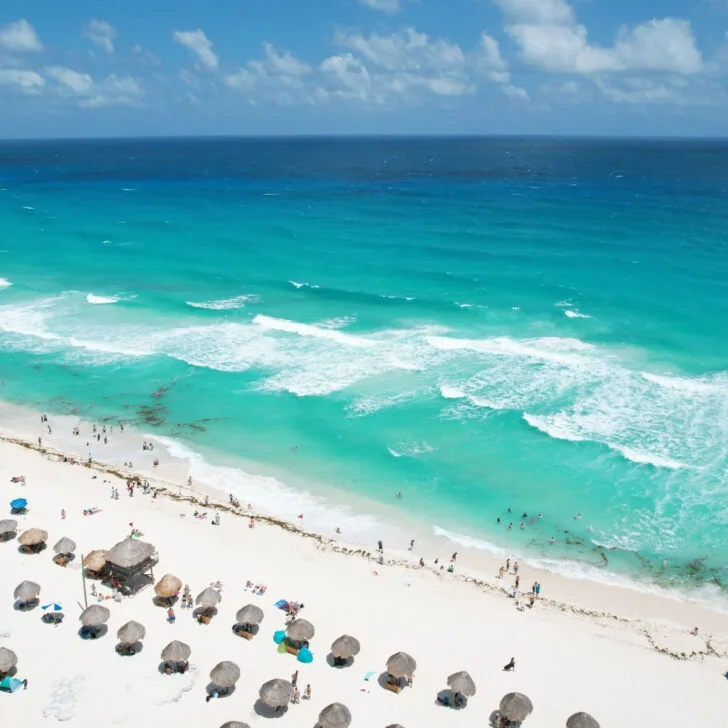If you’re traveling to Cancun or the Mexican Caribbean this summer then I have good news.
According to the experts at Seaweed Watch, the beaches of the Mexican Caribbean are experiencing dramatically reduced levels of sargassum right now and will be completely sargassum-free for much of the summer.
The remaining algae will finish arriving in the first week of July.
Meaning that the beaches of the Mexican Caribbean are forecast to be near sargassum-free from mid-July until September this year. (Though it should be noted this forecast can change).
As someone who sat on a particularly smelly, sargassum-filled beach in Tulum last month, this is very good news.
Here’s what you need to know:
Which Beaches Will Be Sargassum-Free?
The beaches of Cancun and almost all of the Riviera Maya will be sargassum-free this summer.
Only a small amount of sargassum (much smaller than initially estimated) will impact Mexico.
The areas that will be impacted by this are some areas between Mahahual and Xcalak, the east coast of Cozumel, the south of Punta Nizuc, the Sian Ka’an reserve and Tulum.

I spent two weeks dodging stinking sargassum in the Mexican Caribbean last month, and although the cleaning crews did a great job of removing as much as possible, it still definitely negatively impacted the beach experience.
It sticks to your feet, it seems to find you in the water, and it ruins the backdrop of your posey beach photos too!
Where Is The Sargassum Going?
No sargassum? This is great news if you’re heading to Mexico in the next month or two. But the fact is that sargassum doesn’t just disappear.

Well, it’s bad news if you are planning to spend your summer on the beaches of southern Florida.
Satellite images have revealed that the huge masses of sargassum that were originally approaching Mexico have now diverted to southern Florida instead.
And the rest of the algae is expected to land on the Lesser and Greater Antilles, which includes Puerto Rico, the Dominican Republic, Haiti, Cuba and Jamaica.

So, this is great news if you were planning to party on the beaches of Cancun!
But not good news for those travelers heading to Florida or parts of the Caribbean for a beach break this summer.
Why Is Sargassum A Problem?
Sargassum is a huge problem for travelers in the summer months, invading beaches and even making them unusable.
One of the main issues tourists have with sargassum is its ugly appearance, ruining usually pristine beaches.
But once it’s been left in the beach for a few days, that’s when sargassum can become really problematic.
Left out under the hot sun, sargassum starts to smell and begins to rot. Rotting sargassum produces hydrogen sulfide.
Hydrogen sulfide can cause respiratory problems in people who are sensitive to it, so touching it can be dangerous.
And this makes swimming surrounded by it a big no-no too. Where possible you should avoid touching sargassum with bare hands.

Sargassum seaweed is a naturally occurring brown algae that blooms in the Atlantic Ocean each year. And it serves an important purpose to the ocean’s ecosystem.
It provides a home for sea life and other organisms. But it’s not something you want to have to see when you’re taking an idyllic beach vacation!
What To Do If You Experience Sargassum On Your Vacation
It looks like one of the easiest ways to avoid sargassum on your beach vacation this summer is to book flights straight to Cancun.

But if you’ve already booked a trip to Florida or Jamaica, then here are some tips for what to do if you experience sargassum on your vacation:
Choose a resort. Bigger resort hotels are more likely to have their own cleaning crews who will remove the sargassum so that you can still lounge on the beach.
Book a resort with a pool. Sargassum can be unpredictable, and you don’t know how bad it will be when you arrive. But if you have a pool to relax in then your trip won’t be ruined if the beach is inaccessible.
Credit: Source link


